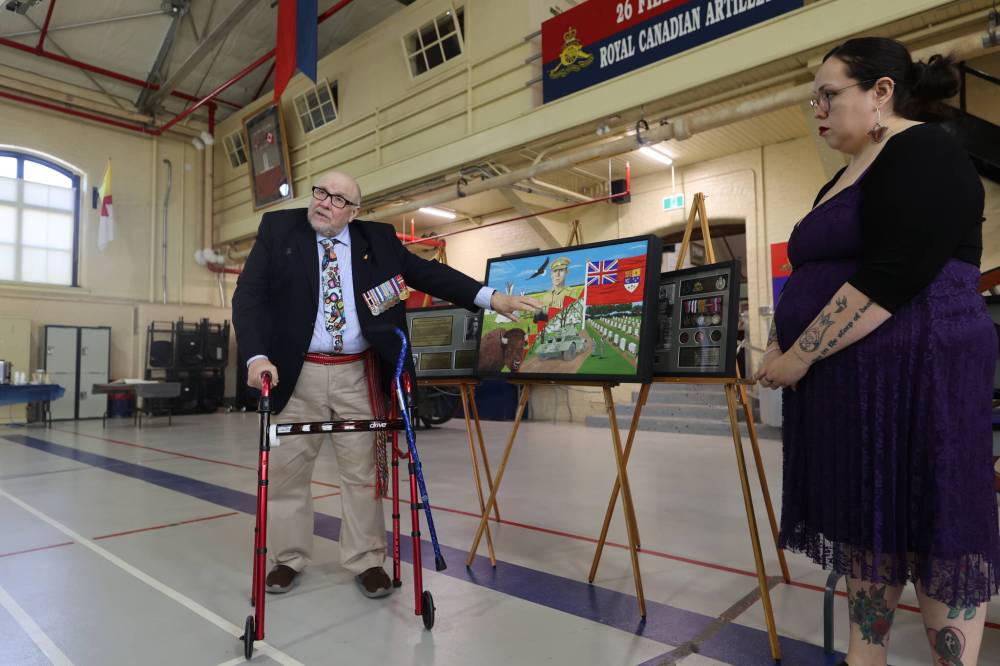Museum honours Indigenous soldiers
Advertisement
Read this article for free:
or
Already have an account? Log in here »
We need your support!
Local journalism needs your support!
As we navigate through unprecedented times, our journalists are working harder than ever to bring you the latest local updates to keep you safe and informed.
Now, more than ever, we need your support.
Starting at $15.99 plus taxes every four weeks you can access your Brandon Sun online and full access to all content as it appears on our website.
Subscribe Nowor call circulation directly at (204) 727-0527.
Your pledge helps to ensure we provide the news that matters most to your community!
To continue reading, please subscribe:
Add Brandon Sun access to your Free Press subscription for only an additional
$1 for the first 4 weeks*
*Your next subscription payment will increase by $1.00 and you will be charged $20.00 plus GST for four weeks. After four weeks, your payment will increase to $24.00 plus GST every four weeks.
Read unlimited articles for free today:
or
Already have an account? Log in here »
Hey there, time traveller!
This article was published 03/06/2024 (515 days ago), so information in it may no longer be current.
A new display at the 26 Field Regiment RCA/XII Manitoba Dragoons Museum will give Indigenous adults and children an opportunity to see their ancestors’ contributions to military service honoured.
The display, which highlights Indigenous soldiers’ efforts in the First World War, Second World War and the Korean War, and their differential treatment under the Indian Act, was unveiled during a ceremony in the Brandon Armoury Saturday morning.
“We feel we’ve finished that last little piece because we’re acknowledging everybody,” museum researcher Ted Krasicki told the Sun. Krasicki served in the artillery and said that he served alongside many Indigenous military members, including those who taught him how to use certain machinery.

Twenty-sixth Field Regiment RCA/XII Manitoba Dragoons Museum curator Edd McArthur speaks to the audience after a new display highlighting the efforts of Indigenous soldiers is unveiled at a Saturday morning ceremony. (Geena Mortfield/The Brandon Sun)
He said that Indigenous people, whether they declared their treaty status or not, were part of many crucial battles in the two world wars. However, he said that in the history books and in the museums the contributions of Indigenous people have been left out.
“(Serving in the military) we always felt that (Indigenous soldiers) were there,” Krasicki said. “And nobody’s saying, ‘Hey, you’re on the team, why aren’t you in the team photo.’ Shouldn’t you be in the team photo?’”
The display consists of four parts — a painting by a Winnipeg-based Indigenous visual artist commissioned by the museum that is housed in the Brandon Armoury, a shadowbox featuring a soldier, Pte. Herman Essie, who was a member of Sioux Valley Dakota Nation, a plaque that honours the most decorated soldiers from the first and second world wars and Korea, and an eagle feather which is a symbol of an Indigenous warrior.
Retired Col. Don Berry, who is president of the museum presented during the ceremony which began with a smudging. He said that Essie served in The Border Horse, the XII Manitoba Dragoons, the Royal Winnipeg Rifles, and the Regina Rifles. He served as both a reservist and as a full-time soldier and was employed as a sniper during the Second World War.
“The museum workers hope that the display will foster pride when Indigenous people visit our museum and in a small way, we hope we contribute to reconciliation,” Berry said to a crowd of around 30 who had gathered for the ceremony.
Brian Midwinter, vice-president of the museum, told the Sun that the Essie family approached the museum with Private Essie’s medals, cap badges and dog tags. Midwinter said the museum was in the midst of trying to figure out how to put together a display that recognized Indigenous soldiers when the Essie family walked in, making the timing perfect.
Midwinter called the unveiling a “very important day.”
The display also features a painting by Jessie Jannuska, an Indigenous visual artist who is based in Winnipeg, but was originally from Brandon. She is a member of Canupawakpa Dakota Nation and said that the painting took her about a month, working 10-hour days.
“I just hope to honour the soldiers and all their sacrifices, whatever they gave, and were not properly recognized for,” Jannuska told the Sun.
Under the Indian Act, Indigenous people did not have to serve in the Canadian military and could not be conscripted. However, thousands of Indigenous people volunteered and served in the Canadian Forces in both world wars and the Korean War. Many served in the army, as the navy and the air force refused to recruit Indigenous people. Records were not kept for non-status Indigenous, Inuit or Métis people, and thousands served without recognition of their Indigenous identity.
Of those who served, more than 500 were killed and many more were wounded. After the wars ended, Indigenous people suffered like many soldiers from post-war trauma, but they were not awarded the same benefits as non-Indigenous veterans. It wasn’t until 2002 that the federal government offered a $20,000 redress package to individual Indigenous veterans. However, as museum researchers noted, by the time the package was received, many of the veterans had already passed away.
» gmortfield@brandonsun.com
» X: @geena_mortfield
